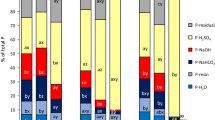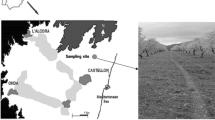Abstract
Goal, Scope and Background
Biosolids, i.e., treated sewage sludge, are commonly used as a fertilizer and amendment to improve soil productivity. Application of biosolids to meet the nitrogen (N) requirements of crops can lead to accumulation of phosphorus (P) in soils, which may result in P loss to water bodies. Since 1996, biosolids have been applied to a Pinus radiata D. Don plantation near Nelson City, New Zealand, in an N-deficient sandy soil. To investigate sustainability of the biosolids application programme, a long-term research trial was established in 1997, and biosolids were applied every three years, at three application rates, including control (no biosolids), standard and high treatments, based on total N loading. The objective of this study was to evaluate the effect of repeated application of biosolids on P mobility in the sandy soil.
Materials and Methods
Soil samples were collected in August 2004 from the trial site at depths of 0–10, 10–25, 25–50, 50–75, and 75–100 cm. The soil samples were analysed for total P (TP), plant-available P (Olsen P and Mehlich 3 P), and various P fractions (water-soluble, bioavailable, Fe and Al-bound, Ca-bound, and residual) using a sequential P fractionation procedure.
Results and Discussion
Soil TP and Olsen P in the high biosolids treatment (equivalent to 600 kg N ha−1 applied every three years) had increased significantly (P<0.05) in both 0–10 cm and 10–25 cm layers. Mehlich 3 P in soil of the high treatment had increased significantly only at 0–10 cm. Olsen P appeared to be more sensitive than Mehlich 3 P as an indicator of P movement in a soil profile. Phosphorus fractionation revealed that inorganic P (Al/Fe-bound P and Ca-bound P) and residual P were the main P pools in soil, whereas water-soluble P accounted for approximately 70% of TP in biosolids. Little organic P was found in either the soil or biosolids. Concentrations of water-soluble P, bioavailable inorganic P (NaHCO3 Pi) and potentially bioavailable inorganic P (NaOH Pi) in both 0–10 and 10–25 cm depths were significantly higher in the high biosolids treatment than in the control. Mass balance calculation indicated that most P applied with biosolids was retained by the top soil (0–25 cm). The standard biosolids treatment (equivalent to 300 kg N ha−1 applied every three years) had no significant effect on concentrations of TP, Mehlich 3 P and Olsen P, and P fractions in soil.
Conclusions
The results indicate that the soil had the capacity to retain most biosolids-derived P, and there was a minimal risk of P losses via leaching in the medium term in the sandy forest soil because of the repeated biosolids application, particularly at the standard rate.
Recommendations and Perspectives
Application to low-fertility forest land can be used as an environmentally friendly option for biosolids management. When biosolids are applied at a rate to meet the N requirement of the tree crop, it can take a very long time before the forest soil is saturated with P. However, when a biosolids product contains high concentrations of P and is applied at a high rate, the forest ecosystem may not have the capacity to retain all P applied with biosolids in the long term.
Similar content being viewed by others
References
American Public Health Administration (1998): Standard methods for the determination of water and wastewater. 4500-P-B.5, 4500-P-E. 20th ed. APHA, 1015 Fifteenth Street, NW, Washington, DC
American Society for Testing and Materials (1990): Standard test method for particle-size analysis of soils. ASTM standard D422-63
Blakemore LC, Searle PL, Dlay BK (1987): Methods for chemical analysis of soils. NZ soil bureau scientific report, pp 80–103
Brock EH, Ketterings QM, Kleinman PJA (2007): Measuring and predicting the phosphorus sorption capacity of manure amended soils. Soil Sci 172, 266–278
Bulter JS, Coale FJ (2005): Phosphorus leaching in manure-amended Atlantic coastal plain soils. J Environ Qual 34, 370–381
Chang AC, Page AL, Sutherland FE, Grgurevic E (1983): Fractionation of phosphorus in sludge-affected soils. J Environ Qual 12, 286–290
Djodjic F, Borling K, Bergstom L (2004): Phosphorus leaching in relation to soil type and soil phosphorus content. J Environ Qual 33, 678–684
Eghball B, Binford GD, Baltensperger DD (1996): Phosphorus movement and adsorption in a soil receiving long-term manure and fertilizer application. J Environ Qual 25, 1339–1343
Elliott HA, Brandt RC, O’Connor GA (2005): Runoff phosphorus losses from surface-applied biosolids. J Environ Qual 34, 1632–1639
Elliott HA, O’Connor GA, Brinton S (2002): Phosphorus leaching from biosolids-amended sandy soils. J Environ Qual 31, 681–689
Heckrath G, Brooks PC, Poulton PR, Goulding KWT (1995): Phosphorus leaching from soils containing different phosphorus concentrations in the broadbalk experiment. J Environ Qual 24, 904–910
Hedley MJ, Stewart JWB, Chauhan BS (1982): Changes in inorganic and organic soil phosphorus fractions by cultivation practice and by laboratory incubations. Soil Sci Soc Am J 46, 970–976
Henry CL, Cole DW, Hinckley TM, Harrison RB (1993): The use of municipal and pulp and paper sludges to increase production in forestry. J Sust For 1(3) 41–55
Hewitt AE (1998): New Zealand soil classification. 2nd ed. Landcare Research Science Ser. 1. Manaaki Whenua Press, Landcare Research, Lincoln, New Zealand
Khiari L, Parent LE, Pellerin A, Alimi ARA, Tremblay C, Simard RR, Fortin J (2000): An agri-environmental phosphorus saturation index for acid coarse-textured soils. J Environ Qual 29, 1561–1567
Kimberley MO, Wang H, Wilks PJ, Fisher CR, Magesan GN (2004): Economic analysis of growth response from a pine plantation forest applied with biosolids. For Eco Manage 189, 345–351
Kleinman PJA, Needelman BA, Sharpley AN, McDowell RW (2003): Using soil phosphorus profile data to assess phosphorus leaching potential in manured soils. Soil Sci Soc Am J 67, 215–224
Kleinman PJA, Sharpley AN (2002): Estimation of soil phosphorus sorption saturation from Mehlich-3 data. Commun Soil Sci Plant Anal 33, 1825–1839
Laturnus F, von Arnold K, Grøn C (2007): Organic contaminants from sewage sludge applied to agricultural soils. False alarm regarding possible problems for food safety? Env Sci Pollut Res 14 (Special Issue 1) 53–60
Maguire RO, Sims JT (2002a): Soil testing to predict phosphorus leaching. J Environ Qual 31, 1601–1609
Maguire RO, Sims JT (2002b): Measuring agronomic and environmental soil phosphorus saturation and predicting phosphorus leaching with Mehlich-3. Soil Sci Soc Am J 66, 2033–2039
McDowell RW, Sharpley AN (2001): Phosphorus losses in subsurface flow before and after manure application to intensively farmed land. Sci Total Environ 278, 113–125
Mehlich A (1984): Mehlich No. 3 soil test extractant: a modification of Mehlich No. 2. extractant. Commun Soil Sci Plant Anal 15, 1409–1416
Murphy J, Riley JP (1962): A modified single solution method for the determination of phosphate in nature water. Anal Chim Acta 27, 31–36
Nelson ON, Parsons JE, Mikkelsen RL (2005): Filed-scale evaluation of phosphorus leaching in acid sandy soils receiving swine waste. J Environ Qual 34, 2024–2035
O’Connor GA, Shaker D, Briton SR, Elliott HA, Martin FG (2004): Phytoavailability of biosolids phosphorus. J Environ Qual 33, 703–712
Pierzynski GM, Gehl KA (2005): Plant nutrient issues for sustainable land application. J Environ Qual 34, 18–28
SAS Institute Inc. (2000): SAS/STAT User’s Guide, Version 8, Vol. 1–3. SAS institute Inc., Cary, NC, USA
Schroeder PD, Radcliff DE, Cabrera ML, Belew CD (2004): Relationship between soil test phosphorus and phosphorus in runoff: effects of soil series variability. J Environ Qual 33, 1452–1463
Sharpley AN, McDowell RW, Kleinman PJA (2004): Amounts, forms and solubility of phosphorus in soils receiving manure. Soil Sci Soc Am J 68, 2048–2057
Shepherd MA, Withers PJ (2001): Phosphorus leaching from digested sewage sludge applied to sandy soils. J Agric Sci 136, 433–441
Sigua GC, Adjei M, Rechcigl J (2005): Cumulative and residual effects of repeated sewage sludge applications: Forage productivity and soil quality implications in South Florida, USA. Environ Sci Pollut Res 12, 80–88
Sims JT, Maguire RO, Leyten AB, Gartley KL, Pautler MC (2002): Evaluation of Mehlich 3 as an agri-envrionmental soil phophorus test for the mid Atlantic United States of America. Soil Sci Soc Am J 66, 2016–2032
Sui YB, Thompson ML, Shang C (1999): Fractionation of phosphorus in Mollsol amended with biosolids. Soil Sci Soc Am J 63, 1174–1180
Wang H, Kimberley MO, Magesan GN, McKinley RB, Lee JR, Lavery JM, Hodgkins PDF, Payn TW, Wilks PJ, Fisher CR, McConchie DL (2006): Mid-rotation effects of biosolids application on tree growth and wood properties in a Pinus radiata plantation. Can J For Res 36, 1921–1930
Wang H, Magesan GN, Kimberley MO, Payn TW, Wilks PJ, Fisher CR (2004): Environmental and nutritional responses of Pinus radiata plantation to biosolids application. Plant Soil 267, 255–262
Withers PJA, Clay SD, Breeze VG (2001): Phosphorus transfer in runoff following application of fertilizer, manure, and sewage sludge. J Environ Qual 30, 180–188
Yang J, He Z, Yang Y, Stoffella P, Yang X, Banks D, Mishra S (2007): Use of Amendments to Reduce Leaching Loss of Phosphorus and Other Nutrients from a Sandy Soil in Florida. Env Sci Pollut Res 14(4) 266–269
Zhang MK, He ZL, Calvert DV, Stoffella PJ, Li YC, Lamb EM (2002): Release potential of phosphorus in Florida sandy soils in relation to phosphorus fractions and adsorption capacity. J Environ Sci Health (part A) 37, 793–80
Author information
Authors and Affiliations
Corresponding author
Additional information
ESS-Submission Editor: Dr. Jean-Paul Schwitzguébel jean-paul.schwitzguebel@epfl.ch
Rights and permissions
About this article
Cite this article
Su, J., Wang, H., Kimberley, M.O. et al. Fractionation and mobility of phosphorus in a sandy forest soil amended with biosolids. Env Sci Poll Res Int 14, 529–535 (2007). https://doi.org/10.1065/espr2007.08.443
Received:
Accepted:
Published:
Issue Date:
DOI: https://doi.org/10.1065/espr2007.08.443




